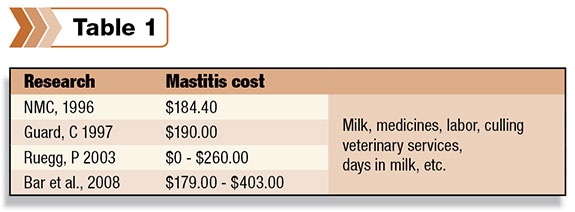Efficiency in all the productive areas is an important factor for dairy farm profitability today. The estimated cost of mastitis in the U.S. is about $2 billion per year, and the cost of an individual case has been estimated from many studies to be from $0 to $400.

One cost included in these estimates is the negative effects of clinical and subclinical mastitis over the reproductive performance.
The biggest losses occur from the subclinical cases that are undetected during the daily operation. About 97 percent of all mastitis cases are “subclinical.” While these cases do not involve visible changes to the quarter or the milk it produces, they do result in lower milk production and an increased somatic cell count.
In 1999, the USDA National Animal Health Monitoring System estimated that a cow with subclinical mastitis lost 1.5 pounds of milk with every increase of one point of linear score. This amounts to an estimated loss of production equivalent to $110 per cow per year.
It is not clear how the inflammatory mediators, hormones and neurotransmitters of the immune response affect the reproductive performance of cows.
The first line of defense against pathogens includes both the physical barriers – such as the skin, keratin plug and closed teat ends – plus the effect of immune cells, such as phagocytes and mammary epithelial cells.
When the physical barriers have been breached by a micro-organism, various immunological defenses are present to either limit the growth or kill the invading micro-organism. Inflammatory mediators are present and involved, coordinating the local and systemic response during clinical mastitis.
The presence of endotoxins from the pathogen induce the release of other chemical neurotransmitters and hormones like histamine, serotonin and prostaglandins (PGF2α) responsible for the local response like heat, redness, swelling, pain and loss of function.
However, these mediators and hormones have not only local but systemic effects that can affect reproductive performance and pregnancy loss.
Research from 2001 found that the time when clinical mastitis occurs can extend days open from 85 days on an uninfected cow to 106 days if the infection occurs before first service, and up to 143 days if the infection occurs between first service and pregnancy diagnosis.
There is also a significant reduction in conception rate. Research from 2004 demonstrated that the occurrence of mastitis is associated with prolonged interval to first postpartum A.I., increased services per conception and prolonged interval from calving to conception.
One possible explanation for the negative effects of mastitis on reproduction was illustrated by 2009 studies that found that 30 percent of cows with clinical or subclinical mastitis had an extended interval between estrous and ovulation of up to 56 hours.
This delay in ovulation would likely compromise the viability of semen relative to oocyte age. Those studies indicate that delayed ovulation was primarily from a direct depression of the estradiol production with the consequent depression of GnRH and LH needed to stimulate ovulation.
There are many risk factors that facilitate mastitis infections; these should be considered as opportunities to reduce clinical mastitis incidence and its negative effects on reproduction. The main risk factors for mastitis include:
- Lactation stage: During the dry period and early lactation, susceptibility to mastitis is higher. The risk of developing clinical mastitis, from either chronic infections or from new environmental infections, is greatest during the peripartum period. The incidence of mastitis during the first 60 days in milk is often 12 percent or higher.
- Housing – stalls: Cows in confinement systems are at higher risk for mastitis than cows on pasture. Similarly, cows in tiestalls are generally at higher risk compared with cows in freestalls.
Regardless of the system, a clean, dry and comfortable environment is key to reducing clinical and subclinical mastitis incidence. Overstocking, dirty lots and any manure accumulation in alleys, tiestalls or freestalls will increase risk.
Stall design will impact the time cows spend lying down; proper size, 2 percent slope and at least 2.5 inches of dry bedding material is important to maintain a dry and clean environment for the udder and to increase cow comfort.
- Feeding: A well-balanced ration that supplies all the nutrients as well as products that enhance health and immune systems will provide a better opportunity to resist mastitis.
- Ventilation: Humidity and high temperatures increase stress and affect milk production. High humidity favors bacterial growth and increases moisture content in bedding material, increasing the risk for mastitis.
- Milking equipment: Eight to 20 percent of new infections can be attributed directly or indirectly to improperly maintained milking equipment.
- Milking procedure: A calm, quiet, efficient, clean and complete milking procedure is fundamental to reduce risk for new mastitis infections. The use of pre-dip and post-dip are the easiest and most cost-effective tools to reduce mastitis incidence.
- Feed delivery: Fresh feed in the bunk when cows return from milking will promote standing for at least 30 minutes to facilitate teat end closure and formation of the keratin plug.
- Regular review: Managers and veterinarians should establish a routine for regular evaluation of udder health status and develop a plan for corrective actions.
Opportunities
Education is the most important tool a manager has to reduce mastitis and its impact on reproduction. The foundation of any milker training, or any other job at the dairy, is not about how, it is about “why.”
All employees, not just milkers, need to understand why they do what they do every day, why it is important to the cows for us to follow procedures and protocols consistently. We all know the parlor is the place where we get money back from all the efforts and investment on a dairy.
I wonder how much time managers and owners spend at the parlor, supervising and encouraging crews to do a good and consistent job?
A dairy is a complex biological web. Tugging on the web in one place will shake up things in another. So it is with reproduction and mastitis. Poor udder preparation or dirty stalls can have a negative influence on reproduction.
Use all the professionals on your team to help you identify weak links that might be having far-ranging negative impacts in other areas of your dairy. PD
References omitted due to space but are available upon request. Click here to email an editor.

-
Christian Rippe
- Global Dairy Technical Specialist
- Vi-Cor
- Email Christian Rippe






